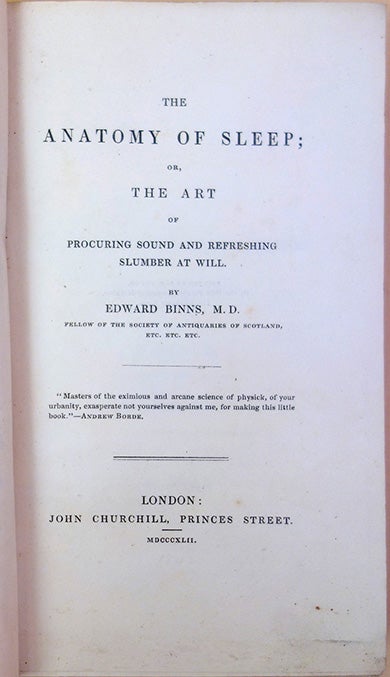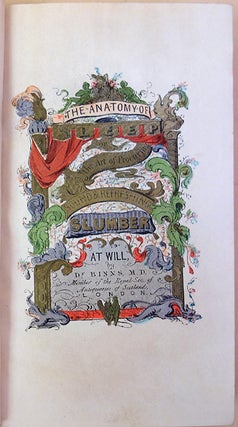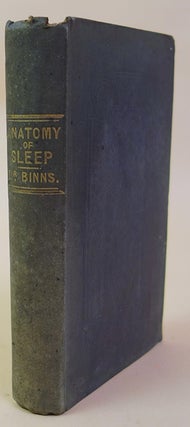The anatomy of sleep
Publisher Information: London: John Churchill, 1842.
The First Book Typeset by a Mechanical Typesetting Machine
Binns, Edward (d. 1851). The anatomy of sleep . . . 8vo. x, 394pp. Hand-colored lithographed title, 3 lithographed plates, text illustrations. London: John Churchill, 1842. 192 x 112 mm. Original cloth, back cover a bit spotted, spine slightly faded and with tiny chips at the top. Edges slightly dust-soiled, otherwise fine. Later ownership inscription on front free endpaper.
First Edition of the first book typeset by the Young & Delcambre Composing Machine, the first composing machine known to have been used for real work in printing offices. The colophon on the verso of the title page states that Binn’s book was “Printed by J. H. Young, by the Patent Composing Machine, 110, Chancery Lane.”
Beginning in the 1840s, several inventors developed and patented mechanical typesetting systems, and it is possible that some were employed without fanfare in provincial newspapers in England for certain periods of time. However, the Young & Delcambre machine is the only one where the machine’s actual work is documented within the publications it produced, likely because Young & Delcambre were aggressive in promoting their technology and got it mentioned in the few publications in which it was used.
Like other early mechanical compositors, the Young & Delcambre machine set a single continuous line of type; line breaking and justification were done later by hand, as was distribution of the types after use. At this stage in the development of machine typesetting, the additional labor needed to operate the machine and distribute the type did not provide enough economic incentive to replace the manual process. These problems would not be adequately addressed until the invention of the Linotype and Monotype type casters which eliminated the redistribution process by melting down the lead type for reuse. Another issue with the Young & Delcambre machine was that it was intended to be operated by women, who were paid less than men, in order to lower the machine’s overall operating costs. “The use of the Young and Delcambre machine was opposed by the London Union of Compositors, particularly because female labour was employed to operate it” (Printing and the Mind of Man: Catalogue of the Exhibitions. . . , no. 463).
It may be interesting to some that efforts to mechanize typesetting occurred about the same time that Charles Babbage was attempting to mechanize calculation through his Difference Engines and his Analytical Engine. Neither the typesetting or calculating technologies caught on when they were first pioneered, chiefly because the early machines could not provide sufficient speed gains or cost savings.
Binns’s book has been rightly valued for its significance in the history of typography and printing, but it also appears to be one of the first books on what we now call sleep research. The author, a physician, began his preface as follows:
"The following attempt to elucidate the laws of procuring sleep at will, by directing the activity of the cerebral organs, is, we believe, the first ever made; or, if any similar attempt has been made, it has escaped our researches . . ."
The chapters cover such topics as “Definition of sleep,” “Drowsiness,” “Hibernation,” Somnambulism,” “Hallucination” and “Phenomena of dreams.” Garrison-Morton.com 7001
Book Id: 44543Price: $1,750.00




